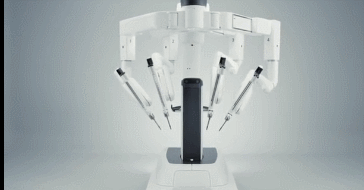DaVinci Surgical System
DaVinci Surgical System
Robotic-assisted surgery with the daVinci® Surgical System allows surgeons to perform complex minimally invasive surgical procedures with precision and accuracy. The system is an advanced robotic platform designed to expand the surgeon’s capabilities and offer an option to open surgery.
The da Vinci System has been successfully used in tens of thousands of procedures. Its safety and efficacy are documented in clinical publications and the literature supporting its use is extensive. At UC Health, we have two daVinci® Surgical Systems to aid our surgeons in surgical procedures for a variety of conditions.
The da Vinci Surgical System provides the surgeon with:
- Precision, dexterity and control during surgery
- The ability to execute 1-2 cm incisions versus longer incisions
The da Vinci Surgical System consists of:
- An ergonomically designed surgeon’s console
- A patient cart with four interactive robotic arms
- A high-performance vision system and patented EndoWrist instruments
daVinci Surgical System Fast Facts
- In 2000, the da Vinci Surgical System became the first robotic surgical platform commercially available in the United States to be cleared by the FDA for use in general laparoscopic surgery.
- There are more than 1,700 da Vinci Systems installed in hospitals worldwide.
- More than 775,000 patients worldwide have had a da Vinci procedure.
- da Vinci procedures are performed for a wide range of conditions in specialties including cardiac, urologic, gynecologic, pediatric and general surgery.
- Recent studies found that when comparing surgical removal of the prostate to radiation, surgery had the lowest cancer death rate.3,4.
The da Vinci System is a remarkable improvement over conventional laparoscopy, in which the surgeon operates while standing and uses hand-held, long-shafted instruments that cannot bend or rotate. With conventional laparoscopy, the surgeon must look up and away from the instruments to a nearby 2D video monitor to see an image of the target anatomy.
The surgeon must also rely on his/her patient-side assistant to position the camera correctly. In contrast, the da Vinci System’s ergonomic design allows the surgeon to operate from a comfortable, seated position at the console, with eyes and hands positioned in line with the instruments. To move the instruments or to reposition the camera, the surgeon simply moves his/her hands.
By providing surgeons with superior vision, enhanced dexterity, greater precision and ergonomic comfort, the da Vinci Surgical System makes it possible for more surgeons to perform minimally invasive procedures involving complex and delicate dissection or reconstruction.



thanks for the qualitative information , would like to appreciate the blogger , if looking for more information related to Biomedical Engineering Courses, Visit:Biomedical Engineering Courses
ReplyDelete